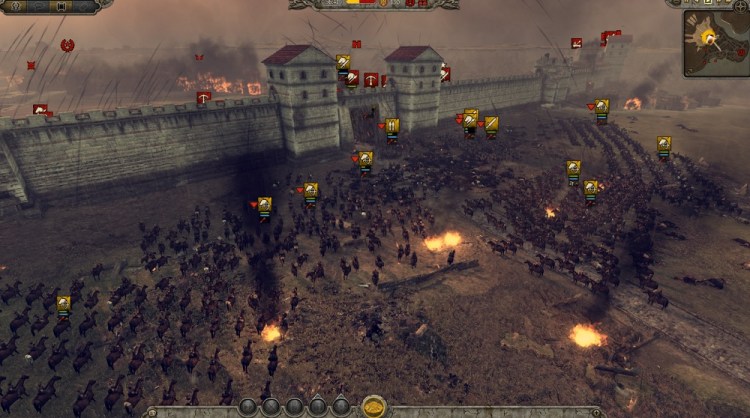Tactical battles are easier to manage
With each battle, you have the option to auto-resolve it, or manually fight. I chose to fight most of the time, because I learned I could get a better result. The battles are what this game is about. If you auto-resolve everything, the game would be not much different from Civilization.
In the tactical fights, Total War: Attila shines. You move your soldiers in cohort-size formations, attacking and countering the enemy as their commander does the same thing. Once the armies lock arms in battle, only one of them comes out standing from the brawling mass that resembles two beehives in combat.
Within the real-time battles, you can zoom in on individual soldiers fighting and pull up to a board-game style view from above. But most of your practical battle management will take place at an angled 3D view, just above your forces. You can zoom in and out with the mouse wheel, and the game responds in a fluid fashion. You can get about 2,000 soldiers on the battlefield in a single formation. That doesn’t seem like much, but it is a good choice by Creative Assembly because it’s harder to control a huge army. But you can still get more of your own soldiers into a fray by positioning several armies together. Once you attack with one, the others will show up as reinforcements who run onto the battlefield in real time against you. I had a few battles with a few thousand soldiers fighting on my side.
The terrain is very important. Like the armies, the landscapes are all beautifully animated. You can fight in dense forests, deserts, or detailed cities. The provincial capitals have their own walls, towers, gates, temples, monuments, squares, and quays. The combat takes place along broad avenues that can become bottlenecks that are defended by a single unit, if necessary. Rain or fog can completely change the nature of the battle as soldiers can bog down and become tired in a torrent or lose sight of the enemy entirely in dense fog. The visual weather changes are top-notch, too.
The pacing is good
If you played every battle, the game would be longer. But it’s also more fun because you get to see the pretty scenery.
In the past, battles were determined quickly because a unit that routed never came back into the fight. You could make a small mistake, leading to one unit panicking and the rest following suit.
But now, the pacing is better. Units that rout can come back after they’ve rested. Fatigued troops are weak, but resting for a short time gives them a lot of morale. That means you can rotate troops out of the fighting. Some can sit on the sidelines and go into the fight fresh when exhausted troops head for the rear. This makes cavalry units particularly powerful and valuable. Raider units can capture gates, towers, and other control points more easily. That allows the side that has more maneuverability to win, particularly in city battles.
Enemy lines will buckle quickly if you pin them in the front and hit them in the flanks or the rear. In short, this means that a good general has more control over the battle. I was almost always able to defend cities with a sufficient garrison of troops, and I often won even with a skeleton garrison. The exciting part is that almost every battle hangs on the bravery of a single unit. If that unit stands its ground, you may be victorious. If it collapses, the entire army may run. That’s what makes Total War: Attila such a joy.
There are also things you can do to improve your odds. You can build siege equipment such as towers, rams, or catapults to blast your enemy’s gates and walls. And if you set the enemy’s city on fire, the troops are more likely to wafer on the front lines. The A.I general will use these tactics too. The enemy will try to take out your towers and walls. When the enemy has taken down your walls and gate, the A.I. will launch the army forward. If you mind the gaps in the walls and hold the gate area, you can make the city assault extremely costly. Sometimes the enemy still does stupid things, but it’s smart enough to put up a good fight.




